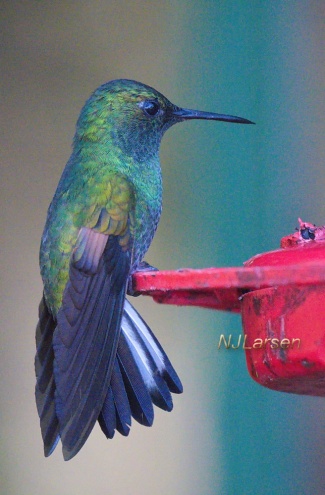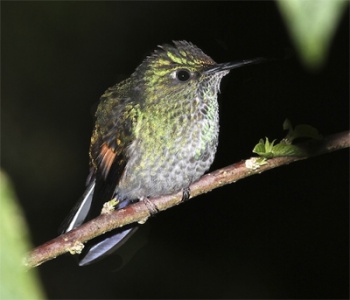- Eupherusa eximia
Identification
10 cm with straight, black bill
Male is mostly green both above and below, with some rusty colors just above the tail on the upper side (extent depending on subspecies), and some yellow wash on underside of the northernmost birds. Tail is dark to bronze except for the outer two tail feathers which are white with black outer edge giving a striped impression of the tail when spread. Folded wings show a cinnamon patch at the secondaries and cinnamon is also visible on the underside of the open wing.
Female is similar but the underside is less green and more grey, while the outer tail feathers have reduced to no black edges.
Similar species
Compare especially with Black-bellied Hummingbird which has mostly white on three outer tail feathers.
Distribution
Southeastern Mexico, through Central America to Costa Rica and western Panama.
Taxonomy

Photo by Stanley Jones
Nueva Suiza, Chiriqui Province, Panama, May, 2012
Subspecies
Three subspecies are recognized[1]:
- E. e. nelsoni
- Humid rainforests of se Mexico (Veracruz and Oaxaca)
- E. e. eximia
- S Mexico (Chiapas) to Belize and n Nicaragua
- E. e. egregia
- Highlands of Costa Rica and w Panama
Habitat
Moist forests, edges, and second-growth, more rarely including scrub. It ranges from foothill elevation in the north to higher in mountains in the southern end of its range.
Behaviour
Food ranges from nectar to insects, some of which are caught by flycatching. This species will also come to feeders if such are provided within their natural habitat.
References
- Clements, J. F., T. S. Schulenberg, M. J. Iliff, D. Roberson, T. A. Fredericks, B. L. Sullivan, and C. L. Wood. 2017. The eBird/Clements checklist of birds of the world: v2017, with updates to August 2017. Downloaded from http://www.birds.cornell.edu/clementschecklist/download/
- Angehr and Dean: The birds of Panama
- Fagan and Komar: Peterson field guide to birds of northern Central America
- HBW alive read March 2018
Recommended Citation
- BirdForum Opus contributors. (2024) Stripe-tailed Hummingbird. In: BirdForum, the forum for wild birds and birding. Retrieved 27 July 2024 from https://www.birdforum.net/opus/Stripe-tailed_Hummingbird
External Links
GSearch checked for 2020 platform.1





